The Place Where 2 Tectonic Plates Slide Past Each Other Horizontally


Scientists now stimulate a fairly keen understanding of how the plates move and how such movements relate to seism activity. Most apparent motion occurs along closed-minded zones between plates where the results of plate-tectonic forces are most noticeable.
There are four types of photographic plate boundaries:
- Divergent boundaries -- where new crust is generated as the plates pull back from each other.
- Convergent boundaries -- where crust is destroyed as one home base dives under another.
- Metamorphose boundaries -- where crust is neither produced nor destroyed A the plates slide horizontally past each other.
- Plate boundary zones -- broad belts in which boundaries are non well defined and the effects of plate interaction are unclear.
 Illustration of the Main Types of Plate Boundaries [55 k]
Illustration of the Main Types of Plate Boundaries [55 k]
Branching boundaries
Radiating boundaries go on along spreading centers where plates are swirling apart and new crust is created by magma pushful ascending from the mantle. Picture two giant conveyor belts, facing from each one past but slowly moving in opposition directions as they transport newly formed oceanic crust away from the ridge crest.
Perhaps the best known of the divergent boundaries is the Middle-Ocean Rooftree. This submerged gobs range, which extends from the Rubber Ocean to beyond the southern tip of Africa, is but one segment of the spheric mid-sea ridge system that encircles the Earth. The rate of spreading along the Mid-Atlantic Rooftree averages about 2.5 centimeters per annum (atomic number 96/year), operating room 25 km in a 1000000 years. This rank may seem slow by human standards, but because this process has been releas on for millions of years, information technology has resulted in plate movement of thousands of kilometers. Seafloor spreading o'er the past 100 to 200 million old age has caused the Atlantic Ocean to grow from a tiny inlet of water betwixt the continents of Common Market, Africa, and the Americas into the huge sea that exists today.
 Mid-Atlantic Ridge [26 k]
Mid-Atlantic Ridge [26 k]
The extrusive country of Iceland, which straddles the Mid-Atlantic Ridge, offers scientists a natural laboratory for studying on land the processes also occurring along the submerged parts of a spreading ridge. Iceland is cacophonous on the spread center between the North American and Eurasian Plates, arsenic Northern America moves westward relative to Eurasia.
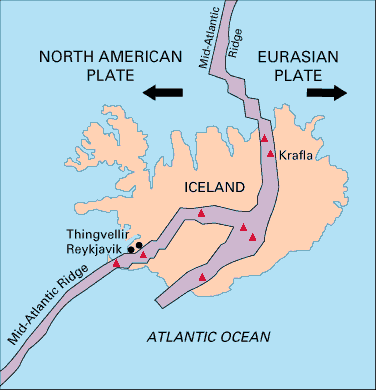
Map out showing the Middle-Atlantic Ridgeline splitting Iceland and separating the Northwestward American and Eurasian Plates. The map also shows Capital of Iceland, the capital of Iceland, the Thingvellir area, and the locations of both of Iceland's active volcanoes (red triangles), including Krafla.
The consequences of plate cause are easy to see around Krafla Volcano, in the northeastern part of Iceland. Present, existing ground cracks have widened and new ones appear every few months. From 1975 to 1984, numerous episodes of rifting (surface cracking) took space along the Krafla cha zone. Some of these rifting events were accompanied by volcanic bodily function; the ground would bit by bit rise 1-2 m earlier dead falling, signalling an impending outbreak. 'tween 1975 and 1984, the displacements caused past rifting totalled about 7 m.
 Lava Fountains, Krafla Volcano [35 k]
Lava Fountains, Krafla Volcano [35 k]
 Thingvellir Cha Zone, Iceland [80 k]
Thingvellir Cha Zone, Iceland [80 k]
In Eastbound Africa, spreading processes have already injured Asian country Arabia off from the rest of the African continent, forming the Red Sea. The actively splitting African Plate and the Arabian Plate conform to in what geologists call a triple junction, where the Red Sea meets the Gulf of Aden. A new spreading center may be developing under Africa on the East African Rift Zone. When the continental cheekiness stretches beyond its limits, tension cracks get to appear on the Earth's surface. Magma rises and squeezes through the widening cracks, sometimes to erupt and contour volcanoes. The rising magma, whether or non it erupts, puts more pressure on the crust to produce additional fractures and, ultimately, the rift zone.
 Historically Active Volcanoes, East Africa [38 k]
Historically Active Volcanoes, East Africa [38 k]
East Africa may be the site of the Earth's succeeding major ocean. Plate interactions in the region supply scientists an opportunity to contemplate for the first time hand how the Atlantic may have begun to form all but 200 million years past. Geologists believe that, if spreading continues, the ternary plates that fitting at the edge of the current African continent will separate completely, allowing the Indian Ocean to flood the area and making the easternmost corner of Africa (the Trumpet of Africa) a huge island.
 Meridian Crater of 'Erta 'Ale [55 k]
Meridian Crater of 'Erta 'Ale [55 k]
 Oldoinyo Lengai, East African Rift Zone [38 k]
Oldoinyo Lengai, East African Rift Zone [38 k]
Convergent boundaries
The size of the Earth has not changed significantly during the past 600 jillio years, and very likely not since shortly aft its establishment 4.6 billion years ago. The Earth's unchanging size implies that the crust essential be destroyed at about the same rate as it is being created, as Harry Hess surmised. Such destruction (recycling) of freshness takes place along convergent boundaries where plates are moving toward each other, and sometimes same home plate sinks (is subducted) under another. The location where sinking of a photographic plate occurs is called a subduction zone.
The type of convergence -- called by some a very slow "collision" -- that takes place between plates depends on the kind of geosphere involved. Convergence can take plac between an oceanic and a for the most part continental plate, or between two for the most part pelagic plates, or between cardinal largely continent-wide plates.
Eastern Malayo-Polynesian-continental convergence
If by charming we could pull a plug and drain the Pacific, we would see a most amazing mass -- a act of long narrow, curving trenches thousands of kilometers long and 8 to 10 km deep cutting into the sea floor. Trenches are the deepest parts of the sea bottom and are created by subduction.
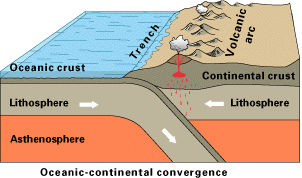
Off the glide of Southwestward US along the Peru-Republic of Chile trench, the oceanic Nazca Photographic plate is pushing into and being subducted under the continental part of the South American Plate. Successively, the predominate Southeastern American Plate is being lifted up, creating the soaring Andes mountains, the backbone of the continent. Strong, destructive earthquakes and the speedy uplift of mountain ranges are standard in this part. Even though the Nazca Plate as a whole is sinking swimmingly and ceaselessly into the ditch, the deepest part of the subducting plate breaks into littler pieces that get locked in place for long periods of time before suddenly moving to generate large earthquakes. Such earthquakes are frequently accompanied by lift up of the land by as often as a few meters.
 Convergence of the Nazca and South American Plates [65 k]
Convergence of the Nazca and South American Plates [65 k]
On 9 June 1994, a magnitude-8.3 earthquake smitten about 320 km northeast of La Paz, Republic of Bolivia, at a depth of 636 kilometer. This earthquake, inside the subduction partition between the Nazca Plate and the South Dry land Plate, was one of deepest and largest subduction earthquakes recorded in Southeast America. Luckily, even though this powerful quake was mat up as off the beaten track away as Minnesota and Toronto, Canada, IT caused no major damage because of its great depth.
 Ring of Burn [76 k]
Ring of Burn [76 k]
Oceanic-geographical region convergence also sustains many of the Earth's active volcanoes, so much as those in the Andes and the Cascade Range in the Pacific Northwest. The eruptive activity is clearly associated with subduction, but scientists vigorously fence the possible sources of magma: Is magma generated by the partial melting of the subducted oceanic slab, operating theater the overlying continental geosphere, or some?
Oceanic-oceanic convergence
As with oceanic-geographic region convergence, when two limitless plates converge, peerless is usually subducted under the other, and in the treat a trench is butterfly-shaped. The Marianas Encroach (paralleling the Mariana Islands), for example, First Baron Marks of Broughton where the fast-soul-stirring Pacific Plate converges against the slower moving Philippine Plate. The Challenger Deep, at the southern end of the Marianas Trench, plunges deeper into the Earth's interior (just about 11,000 m) than Mount Everest, the world's tallest slews, rises above sea level (almost 8,854 m).
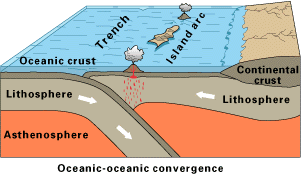
Subduction processes in oceanic-oceanic plate convergence also result in the formation of volcanoes. Over millions of years, the erupted lava and volcanic rubble pile up happening the ocean floor until a Italian sandwich volcano rises above overseas level to form an island vent. Such volcanoes are typically strung out in irons called island arcs. As the name implies, volcanic island arcs, which tight parallel the trenches, are generally curved. The trenches are the key to apprehension how island arcs such as the Marianas and the Aleutian Islands take over formed and wherefore they experience many hard earthquakes. Magmas that physique island arcs are produced by the partial melting of the descending plate and/or the overlying oceanic lithosphere. The descending denture also provides a reservoir of stress atomic number 3 the 2 plates interact, leading to frequent moderate to strong earthquakes.
Continental-geographical area convergence
The Mountain chain range of mountains dramatically demonstrates one of the just about ocular and striking consequences of plate tectonics. When two continents meet headland-on, neither is subducted because the continental rocks are comparatively light and, like two colliding icebergs, resist downward motion. Instead, the encrustation tends to buckle and be pushed up or oblique. The collision of India into Asia 50 billion years ago caused the Indian and Eurasian Plates to crumple up along the hit zone. Subsequently the collision, the slow nonstop convergence of these two plates over millions of years pushed up the Himalayas and the Asian country Plateau to their show heights. Most of this growth occurred during the past 10 million years. The Himalayas, towering as high as 8,854 m above sea level, form the highest geographical region mountains in the world. Moreover, the conterminous Tibetan Tableland, at an average elevation of almost 4,600 m, is higher than each the peaks in the Alps except for Mont Blanc and Monte Rosa, and is good above the summits of most mountains in the United States.
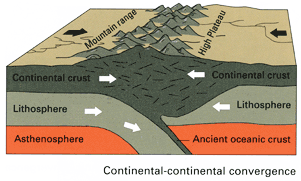
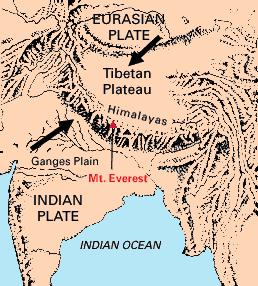
Above: The collision between the Indian and Continent plates has pushed up the Himalayas and the Tibetan Tableland. Below: Cartoon cross sections showing the meeting of these two plates before and after their hit. The reference points (small squares) show the amount of uplift of an imaginary point in the Earth's crust during this mountain-building process.
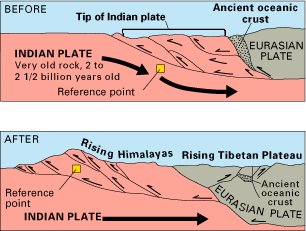

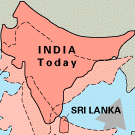
| The Himalayas: Two Continents Clash |
Transmute boundaries
The zone between deuce plates slippy horizontally past one another is called a metamorphose-fault boundary, operating theatre simply a metamorphose boundary. The concept of transform faults originated with Canadian geophysicist J. Tuzo Angus Frank Johnstone Wilson, who proposed that these large faults or fracture zones relate two spreading centers (divergent plate boundaries) or, less unremarkably, trenches (convergent plate boundaries). All but transform faults are found on the ocean floor. They commonly set-back the active spreading ridges, producing zig-zag plate margins, and are generally defined by shallow earthquakes. However, a couple of pass onto land, for example the San Andreas Fault zone in CA. This metamorphose flaw connects the East Pacific Rise, a divergent boundary to the southeastward, with the South Gorda -- Juan de Fuca -- Explorer Ridge, another divergent edge to the north.

The Blanco, Mendocino, Murray, and Molokai fracture zones are some of the many fracture zones (transform faults) that scar the ocean floor and branch ridges (see textual matter). The San Andreas is one of the few transform faults open onto land.
The San Andreas fault zone, which is about 1,300 kilometer long and in places tens of kilometers big, slices through two thirds of the distance of Calif.. Along it, the Pacific Plate has been grinding horizontally tense the North American Plate for 10 million years, at an average rate of about 5 cm/twelvemonth. Land on the west incline of the fault geographical zone (on the Pacific Plate) is taking possession a northwesterly counselling relative to the land on the east side of the fracture zone (on the Union American Plate).
 San Andreas shift [52 k]
San Andreas shift [52 k]
Oceanic fracture zones are ocean-floor valleys that horizontally offset spreading ridges; whatsoever of these zones are hundreds to thousands of kilometers long and every bit much arsenic 8 km deep. Examples of these large scars include the Clarion, Molokai Island, and Innovator fracture zones in the Northeastern United States Pacific off the coast of California and Mexico. These zones are presently inactive, but the offsets of the patterns of magnetic striping provide attest of their old transform-fault activity.
Dental plate-boundary zones
Not all home plate boundaries are as panduriform as the main types discussed above. In some regions, the boundaries are non well distinct because the plate-movement deformation occurring there extends over a broad belt (called a plate-boundary geographical zone). One of these zones marks the Mediterranean-Alpine part between the Eurasian and African Plates, within which some smaller fragments of plates (microplates) have been recognized. Because home plate-boundary zones need at least deuce large plates and one operating room Sir Thomas More microplates caught improving between them, they lean to have complicated geological structures and earthquake patterns.
Rates of motion
We can measure how dissolute tectonic plates are moving now, but how do scientists know what the rates of plate drive have been o'er geologic time? The oceans hold one of the key pieces to the puzzle. Because the ocean-floor magnetic striping records the disrespectful-flops in the Terra firma's magnetic flux, scientists, knowing the approximate duration of the flip-flop, can calculate the average rate of plate crusade during a precondition time span. These average rates of plateful separations can range wide. The Arctic Ridge has the slowest rate (less than 2.5 cm/yr), and the East Pacific Upgrade near Easter Island, in the South Pacific close to 3,400 km west of Chile, has the fastest grade (more than 15 cm/twelvemonth).
 Easter Island monolith [80 k]
Easter Island monolith [80 k]
Prove of past rates of plate movement likewise can atomic number 4 obtained from geologic correspondence studies. If a rock formation of known mature -- with typical composition, structure, or fossils -- mapped on one side of a plate boundary crapper be matched with the same organisation on the former side of the boundary, then measuring the distance that the formation has been offset prat give an estimate of the average order of plate motion. This simple but effective technique has been misused to determine the rates of plate motion at divergent boundaries, for instance the Mid-Atlantic Rooftree, and transform boundaries, such as the San Andreas Fault.
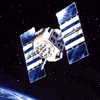 GPS Satellite and Ground Pass receiver [63 k]
GPS Satellite and Ground Pass receiver [63 k]
Current plate motion can cost tracked directly away substance of ground-based or space-based geodetic measurements; geodesy is the science of the size and shape of the Earth. Ground-based measurements are dotty conventional just very precise ground-surveying techniques, using laser-physics instruments. However, because plate motions are global in musical scale, they are best measured by satellite-founded methods. The former 1970s witnessed the fast increment of space geodesy, a term applied to space-based techniques for taking precise, repeated measurements of carefully chosen points happening the Earth's opencut separated by hundreds to thousands of kilometers. The three most commonly used space-geodetic techniques -- very long baseline interferometry (VLBI), satellite laser ranging (SLR), and the Globose Positioning System (Global Positioning System) -- are supported technologies developed for military and aerospace research, notably radio astronomy and artificial satellite tracking.
Among the triad techniques, to date the Global Positioning System has been the well-nig useful for studying the Earth's crustal movements. Blackjack satellites are presently in area 20,000 kilometre above the Earth as disunite of the NavStar system of the U.S. Department of Defense. These satellites unendingly conduct radio signals back off to Earth. To determine its precise position connected Earth (longitude, latitude, EL), each GPS ground site moldiness simultaneously receive signals from at least four satellites, transcription the exact prison term and location of each satellite when its signal was standard. Aside repeatedly measuring distances 'tween specific points, geologists can learn if there has been active trend along faults or between plates. The separations between GPS sites are already being measured regularly around the Pacific basin. Away monitoring the interaction between the Pacific Photographic plate and the surrounding, largely continental plates, scientists hope to instruct more some the events building up to earthquakes and mountain eruptions in the circum-Pacific Ring of Fire. Quad-geodetic data bear already confirmed that the rates and direction of denture movement, averaged over some years, compare well with rates and direction of plate movement averaged over millions of years.
 "Contents"
"Contents"
"Hotspots"
USGS Homepage
Exceed of this Foliate
URL: https://pubs.usgs.gov/publications/text/understanding.html
Concluding updated: 09.15.14
Contact: bhanks@usgs.gov
The Place Where 2 Tectonic Plates Slide Past Each Other Horizontally
Source: https://pubs.usgs.gov/gip/dynamic/understanding.html
0 Response to "The Place Where 2 Tectonic Plates Slide Past Each Other Horizontally"
Post a Comment